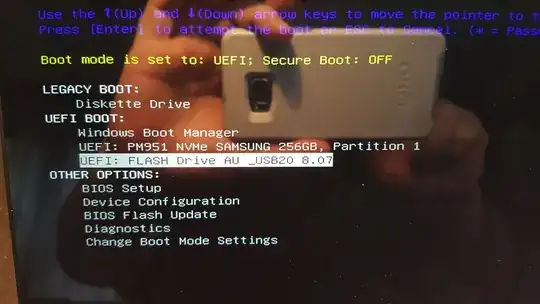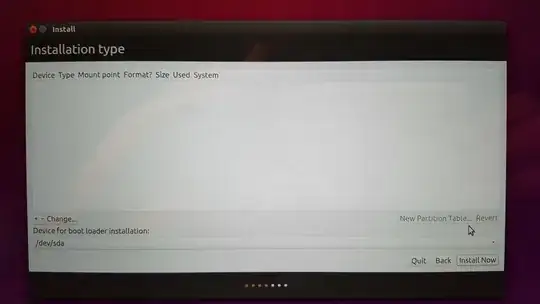I just got a new dell laptop with win10 installed. I want to dual boot with ubuntu (have done that on a couple of desktop machines) but I'm running into a problem.
I'm using this guide
I am able to boot into the usb with the installation iso no problem, I select "try ubuntu" and that is all ok.
I hit install ubuntu, and when I get to the 'installation type' section, the options are all blank.
In gparted, the only visible drive is the 8gb usb drive that contains the installation iso, the system drive is not visible.
The tutorial says I should be given the option of installing alongside windows and sizing the partition, but there is nothing available in that "installation type" dialog.
Update
still having issues. I disabled fast startup and hibernate, here is my bios boot selection: (was not connected to network and unable to save screenshot)
here is the screen during my attempt to install ubuntu from the live usb iso
and here is what shows in gparted (again from the live usb iso):

I found this doc and have been going thru it. I was not able to determine how to disable the intel smart response technology.
Also, as per the tutorial in the link above, I shrunk the volume in disk management in win 10. So I now have a smaller windows partition and half the drive unallocated. Not sure if that is a problem or not.
I also tried creating a usb installer from the 14.04.3 release, same result. Used the utility linked to in the answer below. Same result.
Do the options shown here look ok as per the answers/comments below?
other resources
This Q on askubuntu discusses reinstalling windows in sata/ahci mode (my machine is a dell xps 9350)
Another tutorial on dual boot, specific to xps. Says to update bios (which I did) and to be connected to internet during install. Does not mention ahci
another askubuntu q with some links to resources
further updates
I changed the sata config mode to ahci, that allowed me to install ubuntu and boot into it, but I was not able to boot back into windows.
I then downloaded a win10 iso, and did a clean install with the bios set to ahci. (had to download wifi driver)
I then tried to install ubuntu. In gparted, I still only saw the usb drive, but during the ubuntu install I had the option to "install alongside windows boot manager".
The install process went forward ok, but when I went to restart, I just went straight to windows, there was no grub menu.
thanks!

